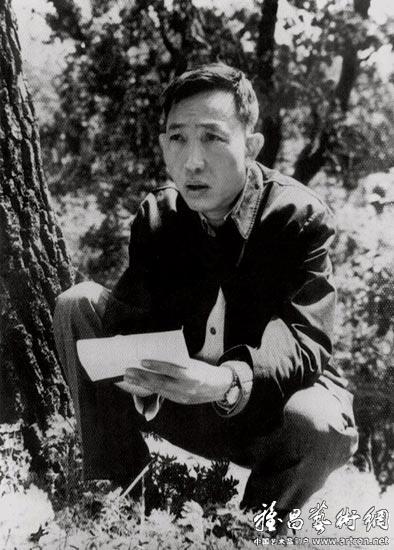
Fu Baoshi (Chinese: 傅抱石), or Fu Pao-Shih, (1904-1965) was a Chinese painter from Xinyu, Jiangxi Province. He went to Japan to study the History of Oriental Art in the Tokyo School of Fine Arts in 1933. He translated many books from Japanese and carried out his own research. In painting itself, he brought Japanese visual elements to the Chinese ink painting tradition.
He was the Director of the Jiangsu Province Chinese Painting School and a Vice-Chairman of the Federation of Chinese Artists. He also taught in the Art Department of Central University (now Nanjing University). His works of landscape painting employed skillful use of dots and inking methods, creating a new technique encompassing many varieties within traditional rules. He was able to create an old, elegant style through his integration of poetic atmosphere and painting techniques. He has held many personal exhibitions in China. In 2011 his first major retrospective exhibition in the west was held by the Cleveland Museum of Arts and the Nanjing Museum.
Fu had strong feelings towards the land of China. During his travel to many places, he recorded the splendors of the rivers and mountains, drawing inspiration from nature and becoming the representative landscape painter of his time.
Personally, Fu Baoshi was my favorite contemporary landscape painting master. I have learned his split-brush painting style through my teacher Huang Chunyao. I always love to read his painting books to learn. As you can see from my Youtube videos I have been teaching Baoshi style landscape painting in my Chinese brush painting class.
This e-book contains a collection of 400 Fu Baoshi's plein air sketches, including the East European tour in 1962 and many other tours throughout China. (Note: the finished paintings are not included in this book.)
Page 464
Dimension 8.89cm x 11.94cm
Color Plates
Published by Nanjing Museum and Rong Baozhai Press, 2007
ISBN 978-7-5003-1020-4
Fu Baoshi, a famous Chinese artist, emphasizes four steps in his approach to painting landscapes from life: explore or You(遊), think sulimely or Wu(悟), record "Ji(記)," and express or "Xie(寫)."
"You" means to tour or explore the scene. It refers to the process of gaining an understanding of the landscape, by observing and identifying its unique characteristics. The idea is to gain a deep understanding of the scene before starting to paint, so that the artist can express the essence of it in his work. As Guo Xi said in "The Lofty Message of Forests and Streams," Mt Song has many good streams, Mt Hua has many good peaks, Mt Heng has many good cliffs, Mt Chang has many good ridges, and Mt Tai has a particularly good main peak." Different landscapes have different characteristics, so it is important to observe deeply and find the characteristics before painting."Wu" or "think sublimely" refers to the artist's deep contemplation and understanding of the landscape and how to express it artistically. It goes beyond physical observation and encompasses a deeper understanding of the scene. This includes the formation of aesthetic ideas and concepts, thinking about how to express the scene, and determining the aesthetic concept of the work. It is more about the "how" of expression, rather than the "what" of the scene. This process is the stage of "mental image" formation. It is a process that is not limited to the physical observation of the landscape, but also encompasses the artist's deeper understanding and contemplation of the scene."Ji" means to record some characteristics and details of the scene, rather than completing the work on the spot. It is important to take note of some features and details to deepen the impression and to accumulate materials for later creation. The idea is to record some important elements that would help the artist to remember the scene better, while he is not painting on the spot. Fu Baoshi only drew a few lines in his sketchbook with the place name and time, a brief notes about color and he would develop those drafty sketches into masterpieces in the next step back in his studio. This step of "Ji" is a way for the artist to preserve the important elements of the scene and to use it as a reference for later work."Xie" means to express the "Yi Xiang" (meaningful image) formed by "You" and "Wu" in previous steps. It is the most important step to achieve the creation of landscape painting. It's the process of taking the understanding and insights gained in the "You" and "Wu" steps and using brush and ink to create a visual representation of it. "Xie" is about expressing the artist's subjective perception of the scene and the emotional response to it, through the language of art. It's the step where the artist puts all the elements together and creates a new aesthetic form that conveys his artistic vision.In summary, Fu Baoshi's four steps theory emphasizes the importance of gaining a deep understanding of the scene, thinking deeply about how to express it, recording important details, and finally, using brush and ink to create a visual representation that conveys the artist's subjective perception of the scene. This approach allows the artist to create a painting that accurately represents the scene while also expressing the artist's own artistic vision.